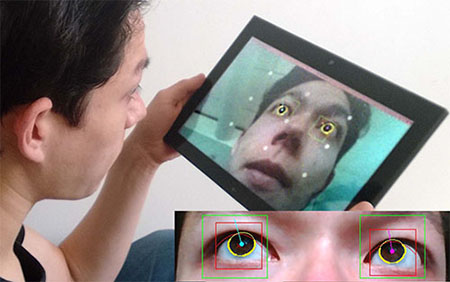EyeTab
EyeTab is a 3D model-based gaze tracker that runs entirely on unmodified commodity tablet computers, taking their limited computational resources and low quality cameras into account.
The code is available in three forms:
EyeTab– A demonstration version which runs on a supplied example video file.EyeTab_SP2– An interactive version developed for a Microsoft Surface Pro 2. This should also work on other devices with small tweaks.EyeTab_Python– A previous iteration of the system written in Python. This was developed rapidly as a prototype so is only included for your curiosity, it is not documented or supported.
The project's webpage can be found here(link is external).
A video of the system in action (Python version) can be seen here(link is external).
Publication
Erroll Wood and Andreas Bulling. 2014. EyeTab: model-based gaze estimation on unmodified tablet computers. In Proceedings of the Symposium on Eye Tracking Research and Applications (ETRA '14) [available at ACM-DL](link is external)
If you use or extend EyeTab code in full or in part, please cite the paper above.
System overview
We track gaze by modelling the iris as a 2D ellipse in an image, and back-projecting this to a 3D circle, getting the real-world position and orientation of the iris. We take the normal vector of this to be the gaze direction.
The system has three main components:
- We first precisely find regions-of-interest for the eyes in an image.
- Then we robustly fit a 2D ellipse to each limbus – the boundary between iris and sclera.
- We finally back-project these to 3D circles, and intersect their normals with the screen for a point-of-gaze.
Deployment instructions
A rough guide for setting this code up from scratch:
- Open the solution file
EyeTab.slnin Visual Studio. I used VS2012. - Add dependencies to Visual Studio' Additional include directories field, Additional library directories field, and as Additional input in the linker.
- Include the
EyeTabheader files in theEyeTab_SP2project. - Ensure the required
.dlls can be found on yourPATHor in Visual Studio's debugging environment. - Build and run the solution.
Dependencies
The system has several dependencies:
- OpenCV(link is external) – a multi-purpose computer vision library
- TBB(link is external) – for parellization
- Eigen(link is external) – provides vector maths
In addition, the SP2 version of the system depends on [VideoInput](// see: http://www.codeproject.com/Articles/559437/Capturing-video-from-web-camera-on-Windows-and(link is external)) for providing high-resolution access to the front-facing camera. OpenCV's camera API is broken and does not support this. This library videoInput.lib is supplied.
NOTE: The VideoInput library only works when targeting 32-bit, but the rest of the system works fine with 64-bit.



 Made by ILUNION for the Prosperity4All project: Ecosystem infrastructure for smart and personalised inclusion and PROSPERITY for ALL stakeholders. This project has received funding from the European Union’s Seventh Programme for research, technological development and demonstration under grant agreement, No 610510.
Made by ILUNION for the Prosperity4All project: Ecosystem infrastructure for smart and personalised inclusion and PROSPERITY for ALL stakeholders. This project has received funding from the European Union’s Seventh Programme for research, technological development and demonstration under grant agreement, No 610510.